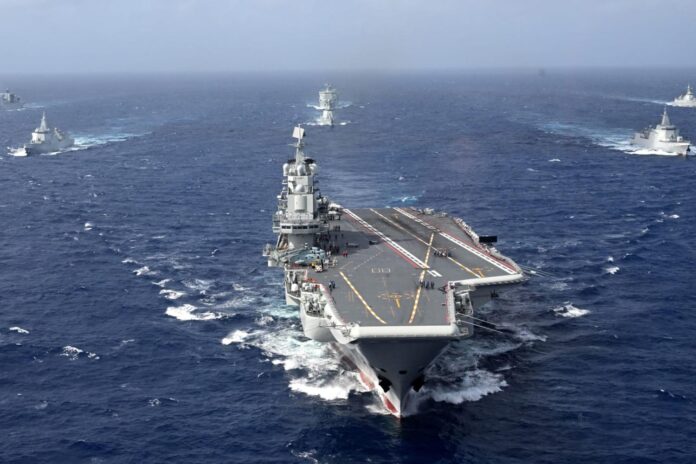
By Clive Williams*
I went to a large military event in Melbourne recently and found the lack of independent thinking about Australia’s strategic circumstances somewhat disappointing – particularly the view that the US will always be our best friend and China our inevitable adversary.
Recent years have indeed seen China accelerate its military modernisation, expanding capabilities and regional reach. That demands Australia’s attention, but it doesn’t mean we should necessarily be in strategic lockstep with the US and treat China as our inevitable enemy.
So, does China’s military rise pose a threat to Australia?
Looking at the stats, China now has the world’s second-largest defence budget. Officially, its 2025 defence appropriation is 1.78 trillion yuan (about US$246 billion) – up 7.2 percent year-on-year. Reputable observers such as SIPRI and CSIS estimate the “true” figure, including military-related expenses, may exceed US$300 billion.
Furthermore, China has the world’s largest military in terms of personnel (roughly two million active-duty troops) with significant numbers of naval vessels, missiles, and aircraft. Its aviation branch is deploying new stealth fighters (such as the J-35) on its three conventionally-powered carriers, expanding their strike potential. China continues to build long-range missile systems, including hypersonic anti-ship cruise variants like the CJ-1000, capable of striking far from its shores.
That said, China’s military capability is uneven. Logistics sustainment, command agility, personnel retention, political control, and limited combat experience are significant constraints. Tight political oversight inhibits military flexibility and responsiveness.
Geography also limits China’s ability to project power. China is surrounded by traditional adversaries and has only one acknowledged overseas base (in Djibouti), though quietly expanding logistics and dual-use facilities abroad. Critical supply chains over long maritime distances remain a major vulnerability.
China is more powerful than ever before, but not in a position to dominate indiscriminately or take unconstrained military risks. For example, it’s likely to be many decades before China could confidently invade and hold Taiwan – even if it wanted to. As Sun Tzu warned, “If it is certain that you can win, then you must fight; if it is not, you must not fight.”
By comparison, the US is vastly more powerful. In 2025, its defence budget was about US$895 billion, roughly three times China’s. It has nearly 750 overseas military bases in over 80 countries, with around 1.3 million active-duty military personnel, 11 nuclear-powered aircraft carriers and unmatched combat experience from decades of operations in Iraq, Afghanistan, and elsewhere. Most significantly, Washington commands a strong global network of formal alliances – while China has none.
Historically, smaller powers aligned with major powers find themselves drawn into wars they might otherwise choose to avoid. Australia has proved especially vulnerable to this scenario. Since the Korean War, we have committed forces to US conflicts in Vietnam, Iraq, and Afghanistan – wars whose purpose and benefits were questionable in terms of our strategic interests.
Experience suggests we’ll continue to support US strategic priorities, even when they diverge from Australia’s, but the US alliance is not necessarily a reliable guarantor of our protection. US defence priorities can shift from one administration to the next.
Importantly, China is Australia’s largest trading partner, with trade volumes more than double those we have with the US. We also have a large trade surplus with China – while we have a trade deficit with the US. People-to-people ties with China are longstanding and deeply entrenched. Treating China as a monolithic adversary limits Australia’s opportunities for engagement, trade, diplomacy, and development of mutual interests.
So, what should Australia do?
Maintain strategic ambiguity: Avoid automatic commitment to any US/China dispute. Retain the freedom to choose our position on a case-by-case basis, preserving leverage and not becoming a de-facto participant in every US confrontation.
Broaden engagement with China: Expand diplomatic, economic, research, cultural, and security dialogues. That includes military-to-military contacts, confidence-building, trade diversification, and joint environmental and infrastructural projects. (One project could be development of a much-needed national fast rail network in Australia.)
Build a more independent defence capability: Invest in a credible deterrent capability serving Australia’s interests, not just those of the US – to include long-range strike, maritime domain dominance, resilient logistics, and enhanced cyber and asymmetric warfighting capabilities.
Diversify alliances and partnerships: Strengthen bilateral ties with regional powers (Japan, India, ASEAN states) and multilateral frameworks (Quad, IORA) to hedge against any declining US regional commitment.
Invest in national resilience: Secure our supply chains, critical infrastructure, alternative energy sources, and build redundancy into essential systems.
In summary, Australia would be better served by preserving a degree of strategic independence, keeping open all lines of engagement, and resisting being drawn into disputes not of our making – such as a conflict over Taiwan. A balanced, independent posture – anchored in a strong domestic military capability and flexible regional alliances – would seem to be our best option in the coming decades.
*Clive Williams is director of the Terrorism Research Centre.



